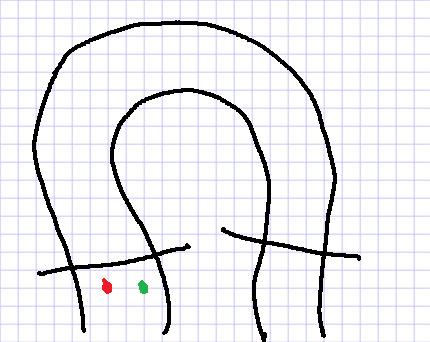When I was around 13 years old there was this guy in my class whose name I cannot for the life of me remember. But I do remember that he was brilliant – off the charts brilliant – and that he shared my love for all things mathematical. He also had abnormally large thumbs. Which might not be important, but it seems worth mentioning.
One day he introduced me to a game which I later realized was one of the best computer games I’ve ever played – except that it did not require a computer.
The idea was simple: Start with a piece of graph paper. Draw a picture of a race track on the graph paper. Make sure to draw a line showing the starting line and another line showing the finish line. Then place two “racers” on the paper – pencil marks denoting some starting position.
Here are the rules: At every move, your racer is allowed to accelerate in either X (left/right)) or Y (up/down) by either -1, 0, or +1. So if your racer was travelling at a speed of, say, (1, 2) in the previous move, then it can now travel between 0 and 2 units in X, and between 1 and 3 units in Y.
You need to get your racer around the track first – before your opponent gets his racer around the track – without going outside of the race track boundaries.
One thing that makes this game so cool is that slight variations in how you draw the outline of the racetrack can result in big changes in the best path around the track.

In the above picture, the track is shown in black. The two “racers”, about to start their way around the track, are shown, respectively, in red and green.
So here was a “computer game” without computers. By playing it we learned about velocity, accelaration and strategic planning. And it cost only about two cents a game – the cost of a sheet of fresh graph paper.